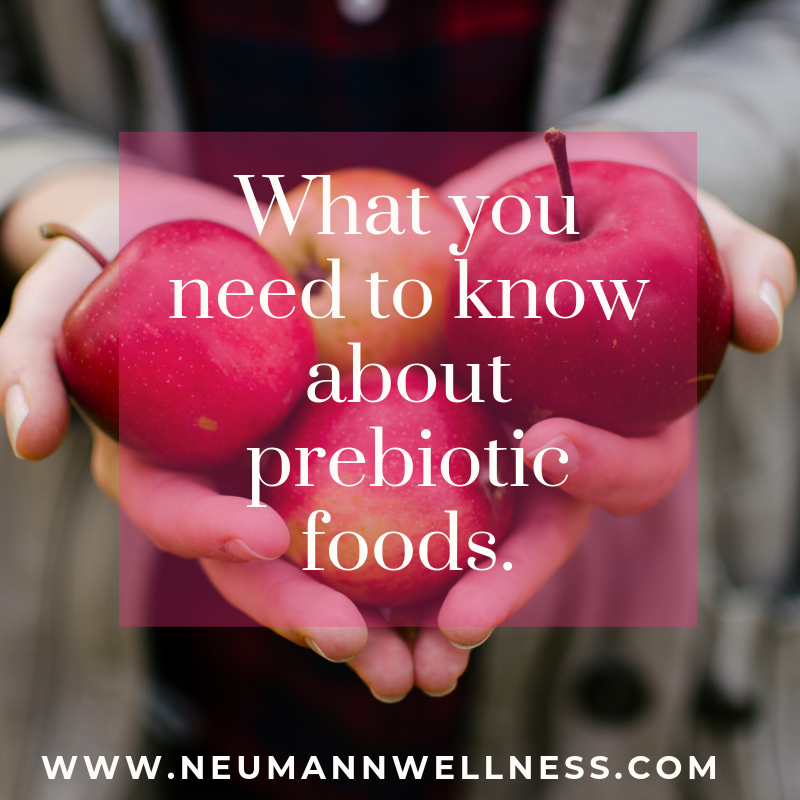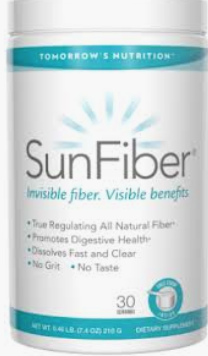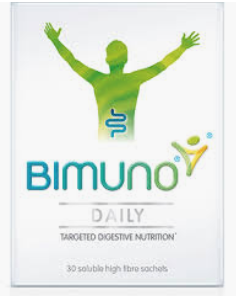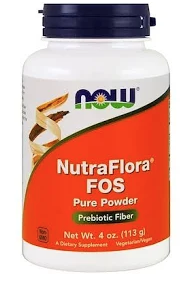What you need to know about prebiotic foods.

In this blog post I’ll cover:
- What are prebiotics and why are they important?
- Health benefits of prebiotics
- Types of prebiotics.
- How much prebiotic do you need?
- How to get prebiotics naturally from your diet.
- My top 10 recommended gluten-free prebiotic foods.
- Twenty prebiotic and probiotic meals & snack ideas to get you started.
- My 3 favorite prebiotic supplements.
INTRODUCTION
Your gut microbiome affects every part of your body from your digestion, to your immune system, your mood, your skin, and your hormones.
When your gut health is compromised, you’re at a higher risk for a whole host of health issues like digestive conditions (such as IBS & Crohn’s), autoimmune conditions, endocrine disorders, mental health issues, obesity, eczema and more.
If you’re struggling with any of these issues, it’s crucial to address your gut health and implement the best strategies to help re-balance your gut microbiome. One way to do this is to implement prebiotic foods into your diet.
WHAT ARE PREBIOTICS & WHY ARE THEY IMPORTANT?
Chances are you’ve heard a lot about probiotics. Probiotics are the beneficial bugs that help support optimal gut balance and are found in fermented foods and supplements.
Prebiotics, on the other hand, are just as important! Prebiotics are basically fiber-rich foods that feed the probiotics and beneficial bacteria that already reside in your gut.
By feeding probiotics with prebiotics, we encourage healthier gut microbes to grow and in the process make us healthier.
Although prebiotics are fiber, not all fiber is prebiotic. The classification of a food to be considered prebiotic involves the following:
- resists gastric acidity and absorption in the upper gastrointestinal (GI) tract
- is fermented by intestinal microflora
- stimulates the growth of intestinal bacteria associated with health and well-being
HEALTH BENEFITS OF PREBIOTICS.
The health effects of prebioitic fibers are far and reaching, they include the following:
- Increased Bifidobacteria and Lactobacilli genus
- Production of beneficial metabolites such as Short Chain Fatty Acids (SCFAs)
- Decreased protein fermentation
- Decreased pathogenic bacteria populations
- Decreased allergy risk
- Improved gut barrier functioning
- Improved immune system defense
- Reduced duration of anti-biotic associated diarrhea
- Enhanced absorption of minerals such as calcium, magnesium, and iron
- Promotion of satiety and weight loss
- Reduced inflammation and symptoms associated with inflammatory bowel diseases
- Protective effects against colon cancer
I don’t know about you, but I think those are all amazing reasons to include more prebiotics in your diet!
TYPES OF PREBIOTICS.
As I mentioned earlier, not all fibers are prebiotic. Prebiotics are characterized into several different types (but are not limited to):
- Oligosaccharides
- FOS (fructooligosaccharides): bananas, onions, garlic, asparagus, leeks, chicory root, burdock, Jerusalem artichoke, produced commercially from sucrose
- GOS (galactooligosaccharides): beans, lentils, Jerusalem artichoke, produced commercially from lactose
- Inulin
- wheat, onion, bananas, garlic, asparagus, Jerusalem artichoke, produced commercially from chicory
- Gums and Mucilages
- guar gum, gum arabic, acacia gum, psyllium, whole grains, legumes, nuts, seeds
- Other non-starch polysaccharides
- pectin in fruits like apples
- beta-glucan in oats, barley and mushrooms
HOW MUCH PREBIOTIC DO YOU NEED?
Foods high in prebiotics have been consumed since prehistoric times. Typical hunter-gatherers consumed up to 135g / day of inulin (a type of prebiotic), while today the average American consumes just 2-8g / day of total prebiotics. That’s quite a gap!
The decrease in prebiotic consumption is likely the result of our increased consumption of refined versions of foods we consume nowadays.
While I don’t recommend you go out and eat 135g of inulin per day (you’ll definitely have a hard time digesting all that!), I do encourage you to think about ways to gradually ADD IN more prebiotic fibers into your daily diet routine.
The verdict is still out on exactly how much prebiotic fiber we should consume. However, some of the regulatory and scientific groups have put forward figures of:
- Dietary fiber for American women: 25g / day
- Prebiotic fiber: 5g-20g / day (from the International Scientific Association for Prebiotics and Probiotics)
It’s important to note, as stated earlier, that prebiotics are considered to be a type of fiber but not all fiber is prebiotic.
At this point in time, we don’t have enough data to tease out exactly how much of each prebiotic fiber you need daily but I feel a safe statement is to opt for a minimum of 5g per day and up to 20g of your total fiber intake from prebitoc foods daily.
Obviously if you’re not used to eating much fiber or prebiotic foods, it’s important to start slowly. Don’t run out and start eating 20g of prebiotic fibers right off the bat if you’re already eating a low fiber diet to start with (such as low FODMAP, keto, etc).
Many of you who might be following a Low FODMAP or a keto diet are seriously missing out on these beneficial prebiotics! I urge you to reconsider these diets in the name of your gut health.
Read on about why the Low FODMAP diet isn’t the answer to solving your digestive issues.
HOW TO GET PREBIOTICS NATURALLY FROM YOUR DIET.
Now that I’ve given you the nitty gritty about the various categories of prebiotics and how much you need, what we really want to focus on are the top 10 gluten-free prebiotic foods you should be including in your diet on a daily basis. These are:
- Jerusalem Artichoke
- Garlic, Leeks, Onions
- Avocado
- Bananas
- Apples
- Whole grains (oats, millet, buckwheat)
- Eggplant
- Jicama Root
- Dandelion Greens & Endive
- Asparagus

Bonus: Resistant Starch, the Dark Horse.
Resistant starch is another non-digestible carbohydrate that is fermented by your gut bacteria and can incur health benefits as a result.
Although (right now) it’s not technically classified as a prebiotic, there’s evidence showing resistant starch displays prebiotic qualities.
One important role resistant starch plays is that it increases the production of Short Chain Fatty Acids (SCFAs) via gut microbes who feed off it. SCFAs are super important because they’re the main source of fuel for your enterocytes (the cells lining your gut) and it reduces overall inflammation in your gut.
The top gluten-free resistant starches are:
- White & Brown rice, cooked then cooled
- Potatoes, cooked then cooled
- GF Oats, cooked then cooled
- Beans & Legumes
- Lentils
- Green bananas
- Plantains
- Potato Starch
- Tiger Nuts

How much resistant starch should you consume? Estimates range from about 20g / day, while the typical American consumes just 5g / day. There’s certainly room for improvement there!
If you start consuming more resistant starch then you’re used to, be careful with the beans, legumes, and lentils. These are often the most problematic for people.
I suggest using Bean Assist which is an enzyme that helps reduce the gassiness and bloating that often accompanies bean consumption. It’s also free of junky fillers and the top food allergens / sensitivities.
HOW TO INCORPORATE PREBIOTIC (& PROBIOTIC FOODS INTO YOUR MEALS.
Now that you know some powerful food sources of prebiotics to include in your diet, it’s important to remember to try and combine these with probiotic foods as well!
Here’s my top 20 prebiotic and probiotic meal & snack ideas to get you started:
- Plantain ceviche + gluten-free crackers or chips to dip
- Dandelion greens + kraut + kefir ranch dressing (or Italian dressing with kombucha)
- Regular Yogurt (or homemade coconut or nutmilk yogurt) + seeds + berries
- Smoothie: coconut water kefir + apple + avocado + honey + mint
- Eggplant lasagna
- Endives + miso-tahini dressing + fermented lime-ginger carrots
- Asian bowl with cooked then cooled rice + endive +stir fried veggies + kimchi
- Potato salad with green beans and asparagus
- Green banana flour brownie bites
- Smoothie: slightly unripe banana + frozen berries + 1 tbsp Bob’s Red Mill Potato Starch + coconut water kefir + honey to sweeten
- Cold rice salad with mango and coconut + fermented apple chutney
- Speedy 3 bean salad
- Plantain tortillas + guacamole + shredded chicken + fermented salsa
- Cozy Millet bowl with mushroom gravy & kale (subs corn starch with potato starch)
- Raw buckwheat breakfast porridge
- Artichoke Tapenade + veggies or buckwheat crackers
- 1 pot everyday lentil soup
- Jicama Salad + beet kvass
- Black bean plantain bowl
- Apple slaw
BEST PREBIOTIC SUPPLEMENTS.
Of course, another option is to supplement with prebiotics.
Although, I always encourage you to opt for food first, supplementation can be an easy and quick way to get your daily prebiotic quota in– and if you know you’re having an off-day it’s a great back up to help fill in those gaps!
The word “prebiotic” is seldomly used on any supplement label. You can find the following terms on the label instead:
- Galacooligosaccharides (GOS)
- Fructooligosaccharides (FOS)
- Oligofructose (OF)
- Chicory Fiber
- Inulin
- Hydrolyzed guar gum
- Galactomannan, etc.
Here are a few of my favorite prebiotic supplements out there:
Sunfiber is an excellent tasteless prebiotic you can mix into any hot or cold food or beverage. It’s made from hydrolyzed guar gum and it’s very well tolerated by most. I recommend starting out with just 1 scoop daily.
Bimuno is made from GOS and it also mixes well into any food or beverage. I recommend starting out with just 1 stick of powder daily.
NutraFlora FOS is a pleasant-tasting natural fiber comprised of concentrated FOS. It has a nice sweet taste. This one is sometimes not as well tolerated by some but still a great option. I recommend starting out with just 2 teaspoons / day.
IN CONCLUSION.
Prebiotics are incredibly important for overall good gut health. As you remember, gut health is tied intimately to so many health issues like digestive conditions, autoimmune conditions, eczema, mental health, endocrine disorders, obesity and more.
Prebiotics encourage healthier gut microbes to grow while inhibiting pathogenic microbes, and in the process makes us healthier.
In short, it’s wise to aim to consume a minimum of 5g per day and up to 20g of your total fiber intake from prebitoc foods daily. Include resistant starches for additional gut health benefits.
It’s best to get your prebiotics from foods and combine them with other probiotic foods. Prebiotic supplements are second-best options if you’re looking for a quick and easy solution to boosting your gut health!
References:
https://www.ncbi.nlm.nih.gov/pmc/articles/PMC3705355/
https://onlinelibrary.wiley.com/doi/full/10.1111/1541-4337.12119
https://www.ncbi.nlm.nih.gov/pmc/articles/PMC6041804/
https://academic.oup.com/jn/article/129/7/1407S/4722578



